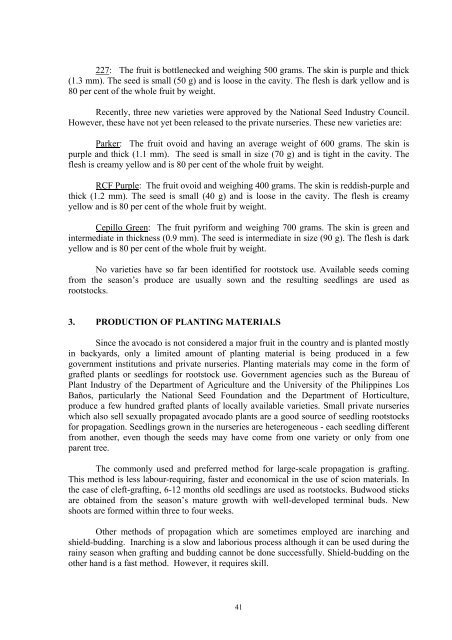Avocado Production in Asia and the Pacific - United Nations in ...
Avocado Production in Asia and the Pacific - United Nations in ...
Avocado Production in Asia and the Pacific - United Nations in ...
You also want an ePaper? Increase the reach of your titles
YUMPU automatically turns print PDFs into web optimized ePapers that Google loves.
227: The fruit is bottlenecked <strong>and</strong> weigh<strong>in</strong>g 500 grams. The sk<strong>in</strong> is purple <strong>and</strong> thick<br />
(1.3 mm). The seed is small (50 g) <strong>and</strong> is loose <strong>in</strong> <strong>the</strong> cavity. The flesh is dark yellow <strong>and</strong> is<br />
80 per cent of <strong>the</strong> whole fruit by weight.<br />
Recently, three new varieties were approved by <strong>the</strong> National Seed Industry Council.<br />
However, <strong>the</strong>se have not yet been released to <strong>the</strong> private nurseries. These new varieties are:<br />
Parker: The fruit ovoid <strong>and</strong> hav<strong>in</strong>g an average weight of 600 grams. The sk<strong>in</strong> is<br />
purple <strong>and</strong> thick (1.1 mm). The seed is small <strong>in</strong> size (70 g) <strong>and</strong> is tight <strong>in</strong> <strong>the</strong> cavity. The<br />
flesh is creamy yellow <strong>and</strong> is 80 per cent of <strong>the</strong> whole fruit by weight.<br />
RCF Purple: The fruit ovoid <strong>and</strong> weigh<strong>in</strong>g 400 grams. The sk<strong>in</strong> is reddish-purple <strong>and</strong><br />
thick (1.2 mm). The seed is small (40 g) <strong>and</strong> is loose <strong>in</strong> <strong>the</strong> cavity. The flesh is creamy<br />
yellow <strong>and</strong> is 80 per cent of <strong>the</strong> whole fruit by weight.<br />
Cepillo Green: The fruit pyriform <strong>and</strong> weigh<strong>in</strong>g 700 grams. The sk<strong>in</strong> is green <strong>and</strong><br />
<strong>in</strong>termediate <strong>in</strong> thickness (0.9 mm). The seed is <strong>in</strong>termediate <strong>in</strong> size (90 g). The flesh is dark<br />
yellow <strong>and</strong> is 80 per cent of <strong>the</strong> whole fruit by weight.<br />
No varieties have so far been identified for rootstock use. Available seeds com<strong>in</strong>g<br />
from <strong>the</strong> season’s produce are usually sown <strong>and</strong> <strong>the</strong> result<strong>in</strong>g seedl<strong>in</strong>gs are used as<br />
rootstocks.<br />
3. PRODUCTION OF PLANTING MATERIALS<br />
S<strong>in</strong>ce <strong>the</strong> avocado is not considered a major fruit <strong>in</strong> <strong>the</strong> country <strong>and</strong> is planted mostly<br />
<strong>in</strong> backyards, only a limited amount of plant<strong>in</strong>g material is be<strong>in</strong>g produced <strong>in</strong> a few<br />
government <strong>in</strong>stitutions <strong>and</strong> private nurseries. Plant<strong>in</strong>g materials may come <strong>in</strong> <strong>the</strong> form of<br />
grafted plants or seedl<strong>in</strong>gs for rootstock use. Government agencies such as <strong>the</strong> Bureau of<br />
Plant Industry of <strong>the</strong> Department of Agriculture <strong>and</strong> <strong>the</strong> University of <strong>the</strong> Philipp<strong>in</strong>es Los<br />
Baños, particularly <strong>the</strong> National Seed Foundation <strong>and</strong> <strong>the</strong> Department of Horticulture,<br />
produce a few hundred grafted plants of locally available varieties. Small private nurseries<br />
which also sell sexually propagated avocado plants are a good source of seedl<strong>in</strong>g rootstocks<br />
for propagation. Seedl<strong>in</strong>gs grown <strong>in</strong> <strong>the</strong> nurseries are heterogeneous - each seedl<strong>in</strong>g different<br />
from ano<strong>the</strong>r, even though <strong>the</strong> seeds may have come from one variety or only from one<br />
parent tree.<br />
The commonly used <strong>and</strong> preferred method for large-scale propagation is graft<strong>in</strong>g.<br />
This method is less labour-requir<strong>in</strong>g, faster <strong>and</strong> economical <strong>in</strong> <strong>the</strong> use of scion materials. In<br />
<strong>the</strong> case of cleft-graft<strong>in</strong>g, 6-12 months old seedl<strong>in</strong>gs are used as rootstocks. Budwood sticks<br />
are obta<strong>in</strong>ed from <strong>the</strong> season’s mature growth with well-developed term<strong>in</strong>al buds. New<br />
shoots are formed with<strong>in</strong> three to four weeks.<br />
O<strong>the</strong>r methods of propagation which are sometimes employed are <strong>in</strong>arch<strong>in</strong>g <strong>and</strong><br />
shield-budd<strong>in</strong>g. Inarch<strong>in</strong>g is a slow <strong>and</strong> laborious process although it can be used dur<strong>in</strong>g <strong>the</strong><br />
ra<strong>in</strong>y season when graft<strong>in</strong>g <strong>and</strong> budd<strong>in</strong>g cannot be done successfully. Shield-budd<strong>in</strong>g on <strong>the</strong><br />
o<strong>the</strong>r h<strong>and</strong> is a fast method. However, it requires skill.<br />
41
















